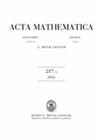形式CR映射的收敛性和发散性
IF 6.7
1区 数学
Q1 MATHEMATICS
引用次数: 9
摘要
一个形式全纯映射H:(M,p)!从实解析子流形M⊂C在p∈M上的胚到实解析子集M′⊁CN′的M′是满足H(p)∈M′的形式全纯幂级数H=(H1,…,HN′)的N′-元组,其性质是,对于实解析函数δ(w,w)在H(p。有大量的例子表明形式映射可能会发散:在复子流形的自映射的平凡例子之后,可能最简单的非平凡例子是由(R,0)到R的形式映射给出的,这些形式映射只是由z∈C中具有实系数的形式幂级数给出的,即由R[[z]]的元素给出的。起初,一个令人惊讶的事实是,对于复空间中实子流形之间的形式映射,如果假设在适当的意义上排除了上面的平凡例子,情况就根本不同了。Chern和Moser在[CM]中遇到了第一个这样的结果,其中——作为它们正规形式收敛的副产品——它得出了C中Levion退化超曲面之间的每个形式全纯可逆映射必然收敛。收敛性问题,也就是说,如上所述,决定形式映射是否实际上是收敛的,已经在不同的上下文中进行了深入的研究,无论是对于CR流形还是对于具有CR奇点的流形,对此,我们请读者参阅论文[Rot]、[MMZ2]、[LM1]、[HY1]、[HY2]、[HY3]、[Sto]、[GS]及其参考文献。收敛问题的解有重要的应用,例如,双全纯等价本文章由计算机程序翻译,如有差异,请以英文原文为准。
Convergence and divergence of formal CR mappings
A formal holomorphic map H: (M,p)!M ′ from a germ of a real-analytic submanifold M⊂C at p∈M into a real-analytic subset M ′⊂CN ′ is an N ′-tuple of formal holomorphic power series H=(H1, ...,HN ′) satisfying H(p)∈M ′ with the property that, for any germ of a real-analytic function δ(w, w) at H(p)∈C ′ which vanishes on M ′, the formal power series δ(H(z), H(z)) vanishes on M . There is an abundance of examples showing that formal maps may diverge: After the trivial example of self-maps of a complex submanifold, possibly the simplest non-trivial example is given by the formal maps of (R, 0) into R which are just given by the formal power series in z∈C with real coefficients, that is, by elements of R[[z]]. It is a surprising fact at first that, for formal mappings between real submanifolds in complex spaces, if one assumes that the trivial examples above are excluded in a suitable sense, the situation is fundamentally different. The first result of this kind was encountered by Chern and Moser in [CM], where—as a byproduct of the convergence of their normal form—it follows that every formal holomorphic invertible map between Levinon-degenerate hypersurfaces in C necessarily converges. The convergence problem, that is, deciding whether formal maps, as described above, are in fact convergent, has been studied intensively in different contexts, both for CR manifolds and for manifolds with CR singularities, for which we refer the reader to the papers [Rot], [MMZ2], [LM1], [HY1], [HY2], [HY3], [Sto], [GS] and the references therein. Solutions to the convergence problem have important applications, for example, to the biholomorphic equivalence
求助全文
通过发布文献求助,成功后即可免费获取论文全文。
去求助
来源期刊

Acta Mathematica
数学-数学
CiteScore
6.00
自引率
2.70%
发文量
6
审稿时长
>12 weeks
期刊介绍:
Publishes original research papers of the highest quality in all fields of mathematics.
 求助内容:
求助内容: 应助结果提醒方式:
应助结果提醒方式:


